Slide 1

TEXT VERSION OF SLIDE:
Title: Silent Killer in a Newly Constructed Manhole
Type: Text and Image Slide
Content:
This is a photo down a manhole as well as an OSHA logo.
Slide 2
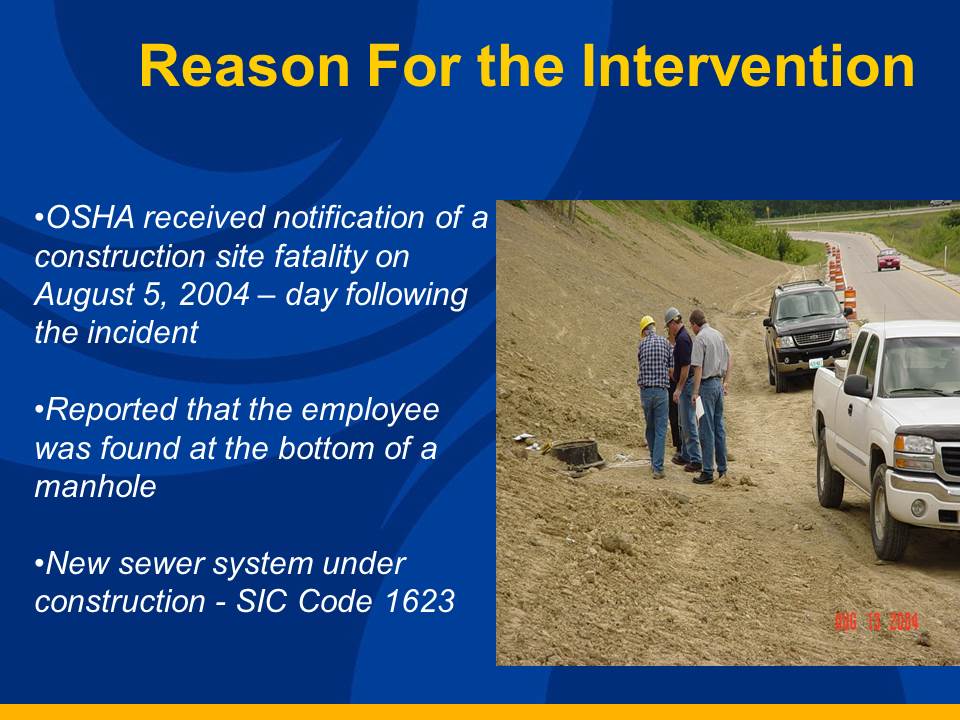
TEXT VERSION OF SLIDE:
Title: Reason For the Intervention
Type: Text and Image Slide
Content:
- OSHA received notification of a construction site fatality on August 5, 2004 - day following the incident
- Reported that the employee was found at the bottom of a manhole
- New sewer system under construction - SIC Code 1623
Note:
- The inspection was initiated after our office received notification of a construction site fatality from the employer on August 5, 2004, which was a day after the incident.
- The report was that the employee was found at the bottom of a newly constructed manhole.
- The employer was a small construction company with a total of 20 employees. The company installs water and sewer lines, with a SIC Code of 1623.
[Image of workers standing around a manhole]
Slide 3

TEXT VERSION OF SLIDE:
Title: The Site
Type: Text and Image Slide
Content:
- Company laying sewer pipe & manholes for a new housing development
- 6 employees onsite
- Farm land; slightly hilly; slope of ground ~ 1 to 4
- Manhole was adjacent to an entrance ramp to a highway
Note:
- The employer was laying sewer pipe and manholes for a new housing development.
- There were 6 employees on site the day of the incident - five of the employees were laying pipe over the hill from the manhole that was involved in the incident. One employee (the victim) was grouting the manhole.
- This photo shows the manhole from top of the hill looking down.
- The area was previously farm land, it was slightly hilly, and the manhole was placed in the terrain with a slope of 1 to 4.
- The manhole was adjacent to entrance ramps to a highway.
[Image of workers at the site]
Slide 4
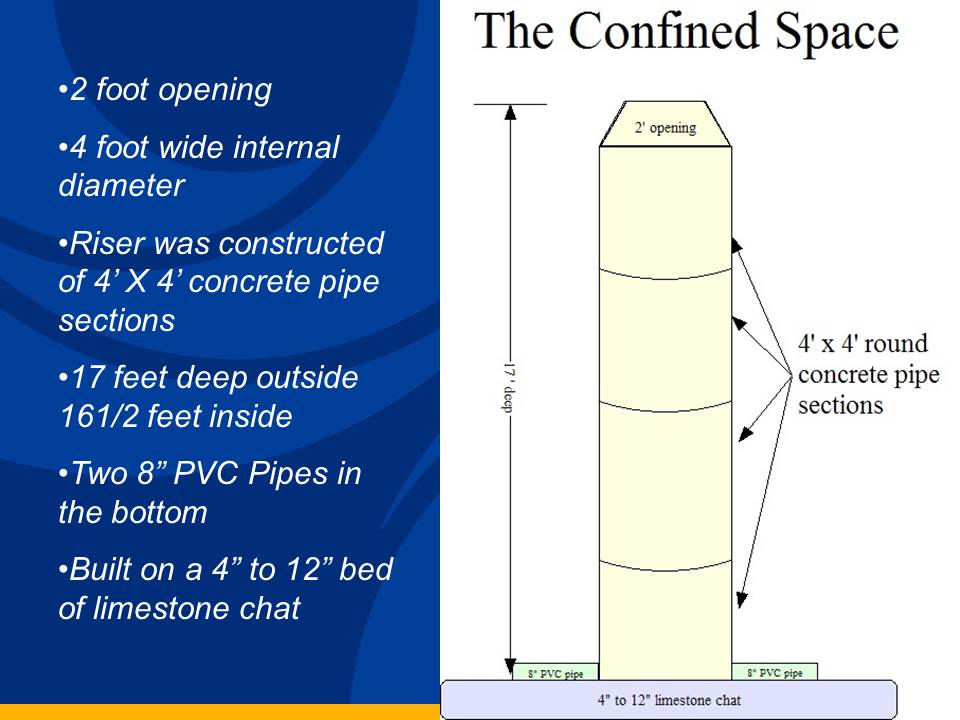
TEXT VERSION OF SLIDE:
Title: The Confined Space
Type: Text and Image Slide
Content:
- 2 foot opening
- 4 foot wide internal diameter
- Riser was constructed of 4' X 4' concrete pipe sections
- 17 feet deep outside 16 1⁄2 feet inside
- Two 8" PVC Pipes in the bottom
- Built on a 4" to 12" bed of limestone chat
Note:
- This slide gives a break down of the sections of the manhole.
- There were 4 sections with a total height of approximately 17 feet when measured on the outside (per drawings), and the inside measurement was 16 1⁄2 feet (when measured with a trench pole). All of the sections were made of concrete and were coated with a water proofing substance. Ladder rungs were present in the interior surface.
- There was a 2 foot opening at the top, and 4 foot wide internal diameter.
- The manhole was set in a bed of gravel any where from 4 to 12 inches.
- Two eight inch plastic sewer pipe enters and exits the manhole near the bottom.
- At the time of the incident and the inspection activity, the inlets were plugged.
[Illustration of the confined space]
Slide 5
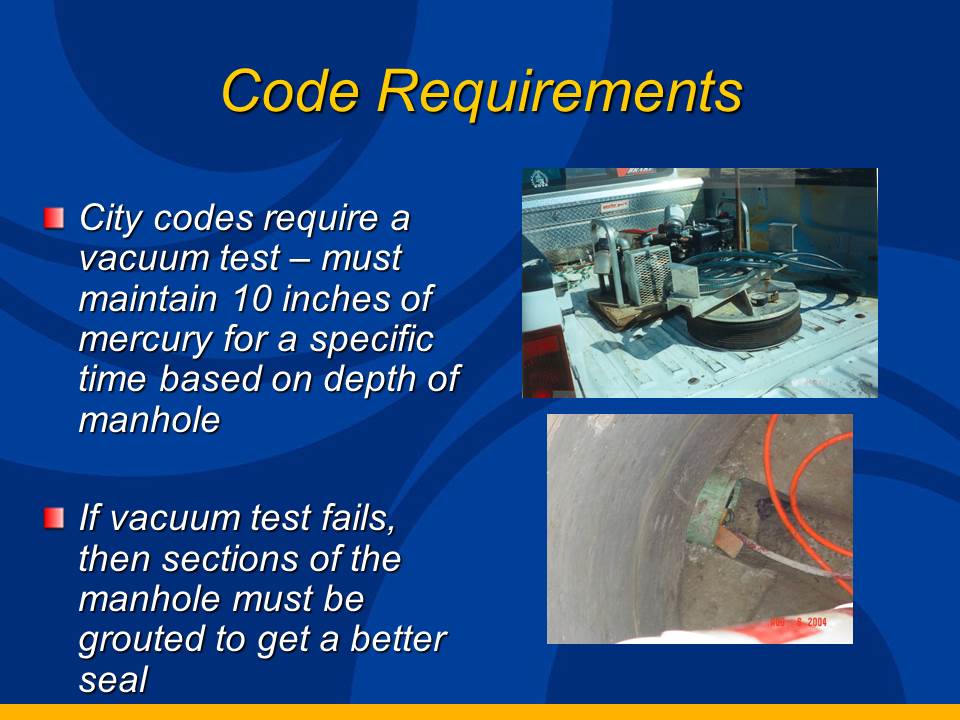
TEXT VERSION OF SLIDE:
Title: Code Requirements
Type: Text and Image Slide
Content:
- City codes require a vacuum test - must maintain 10 inches of mercury for a specific time based on depth of manhole
- If vacuum test fails, then sections of the manhole must be grouted to get a better seal
Note:
- As stated earlier, there were 6 employees on site the day of the accident. 5 of the employees were working over the hill laying sewer pipe. The victim was assigned the job of grouting.
- Each manhole, per city codes, must pass a leak test, which is accomplished by pulling a vacuum and the manhole must hold a vacuum of 10 inches of mercury for a set time based on the depth of the manhole.
- This slide shows the vacuum test equipment. The upper photo shows the apparatus which seals the top of the manhole and the vacuum pump. The lower photo shows the plug inserts which are placed in the sewer pipe entering the bottom of the manhole and completes the sealed space.
- If this test fails, as in this case, someone has to grout the seams of the manhole sections.
[Images of vacuum test equipment, including manhole seal, vacuum pump, and plug inserts.]
Slide 6
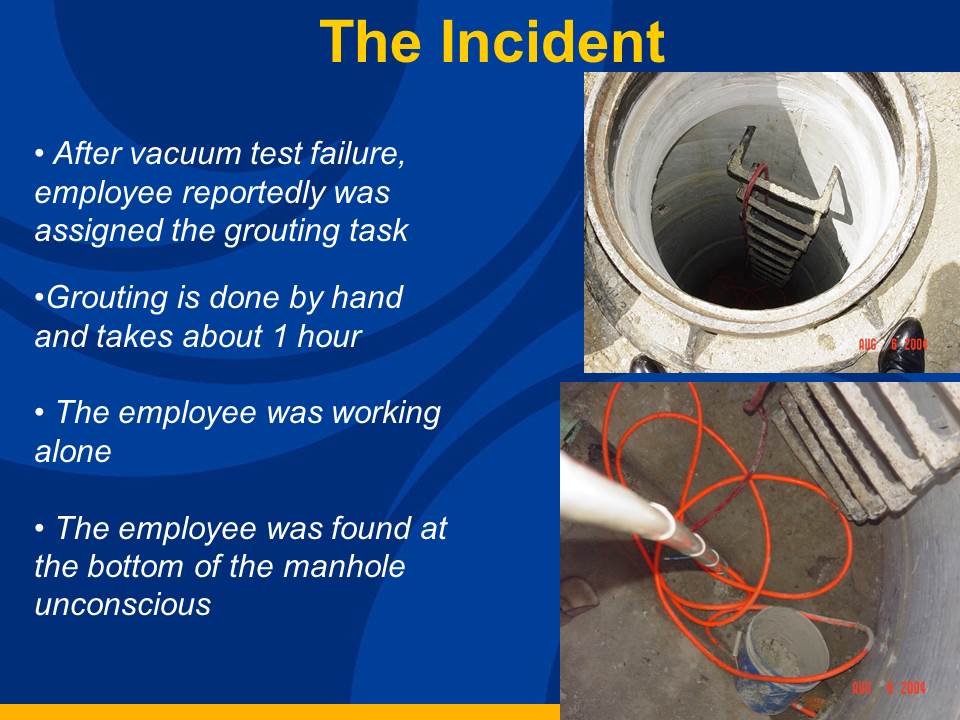
TEXT VERSION OF SLIDE:
Title: The Incident
Type: Text and Image Slide
Content:
- After vacuum test failure, employee reportedly was assigned the grouting task
- Grouting is done by hand and takes about 1 hour
- The employee was working alone
- The employee was found at the bottom of the manhole unconscious
[Images of the manhole interior]
Slide 7
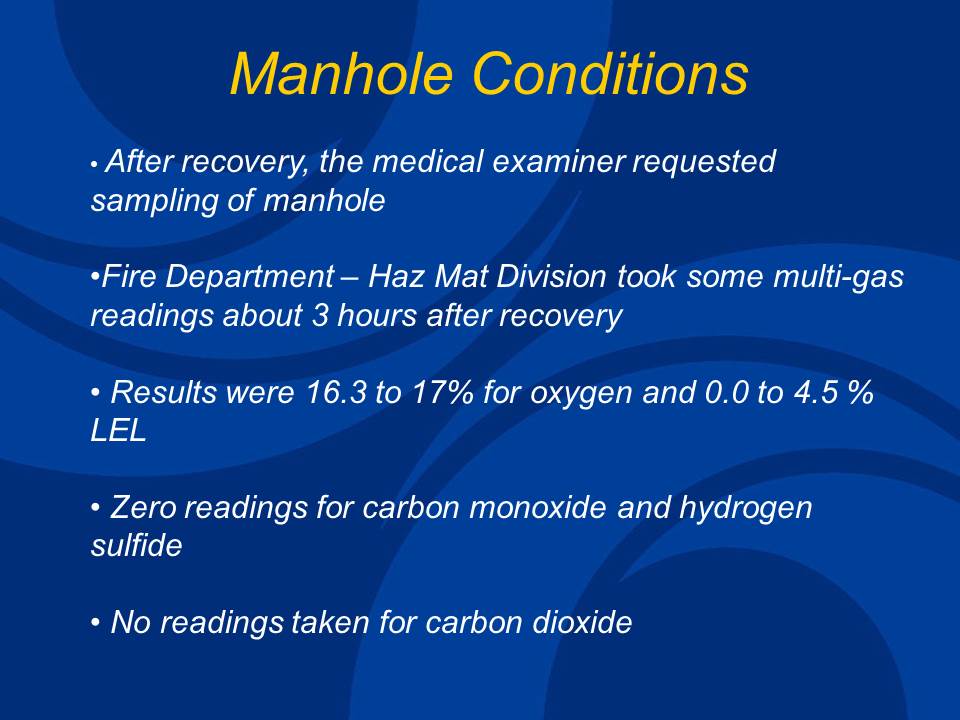
TEXT VERSION OF SLIDE:
Title: Manhole Conditions
Type: Text Slide
Content:
- After recovery, the medical examiner requested sampling of manhole
- Fire Department - Haz Mat Division took some multi-gas readings about 3 hours after recovery
- Results were 16.3 to 17% for oxygen and 0.0 to 4.5 % LEL
- Zero readings for carbon monoxide and hydrogen sulfide
- No readings taken for carbon dioxide
Slide 8
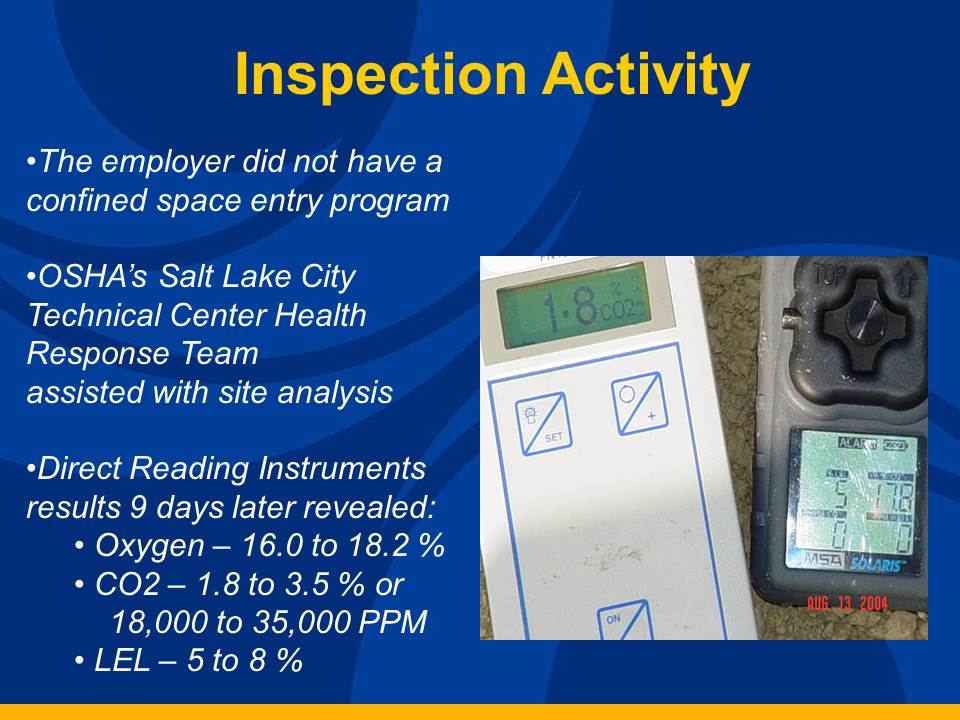
TEXT VERSION OF SLIDE:
Title: Inspection Activity
Type: Text and Image Slide
Content:
- The employer did not have a confined space entry program
- OSHA's Salt Lake City Technical Center Health Response Team assisted with site analysis
- Direct Reading Instruments results 9 days later revealed:
- Oxygen - 16.0 to 18.2 %
- CO2 - 1.8 to 3.5 % or 18,000 to 35,000 PPM
- LEL - 5 to 8 %
[Image of direct reading instruments]
Slide 9

TEXT VERSION OF SLIDE:
Title: Inspection Activities (cont.)
Type: Text and Image Slide
Content:
- Grab or bulk air samples taken with a medium flow pump at 3 L/Min.
- Collected in aluminum bags
- Lab results as follows:
- Oxygen - 12.5 to 14.1 %
- CO2 - 16,845 to 23,968 PPM
- Methane - 776 to 1372 PPM
[Image of air sampling]
Slide 10
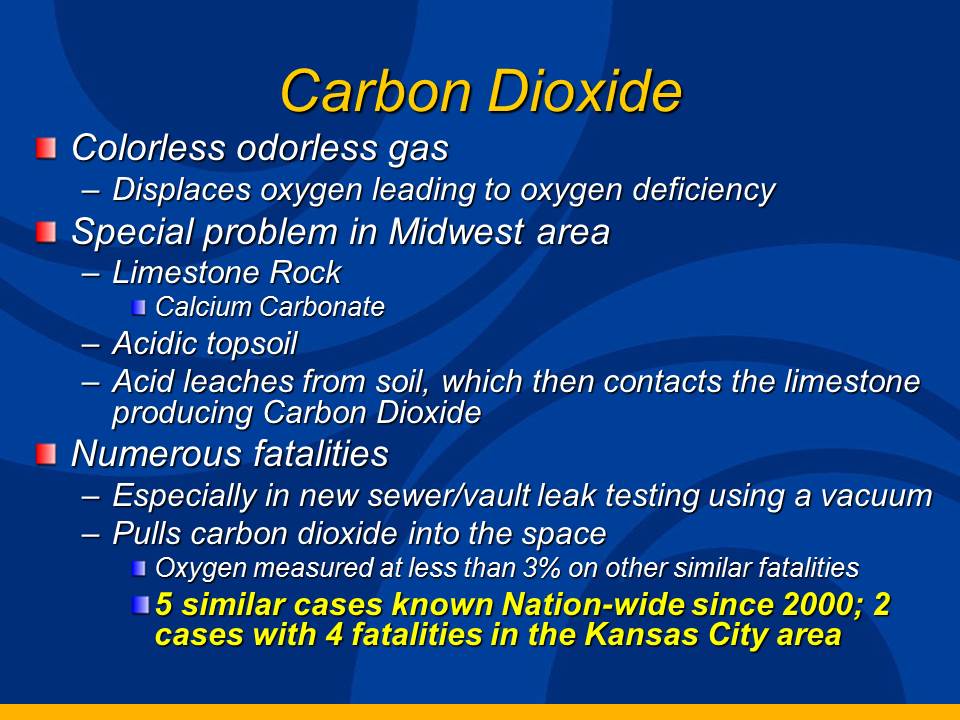
TEXT VERSION OF SLIDE:
Title: Carbon Dioxide
Type: Text Slide
Content:
- Colorless odorless gas
- Displaces oxygen leading to oxygen deficiency
- Special problem in Midwest area
- Limestone Rock
- Calcium Carbonate
- Acidic topsoil
- Acid leaches from soil, which then contacts the limestone producing Carbon Dioxide
- Limestone Rock
- Numerous fatalities
- Especially in new sewer/vault leak testing using a vacuum
- Pulls carbon dioxide into the space
- Oxygen measured at less than 3% on other similar fatalities
- 5 similar cases known Nation-wide since 2000; 2 cases with 4 fatalities in the Kansas City area
Slide 11
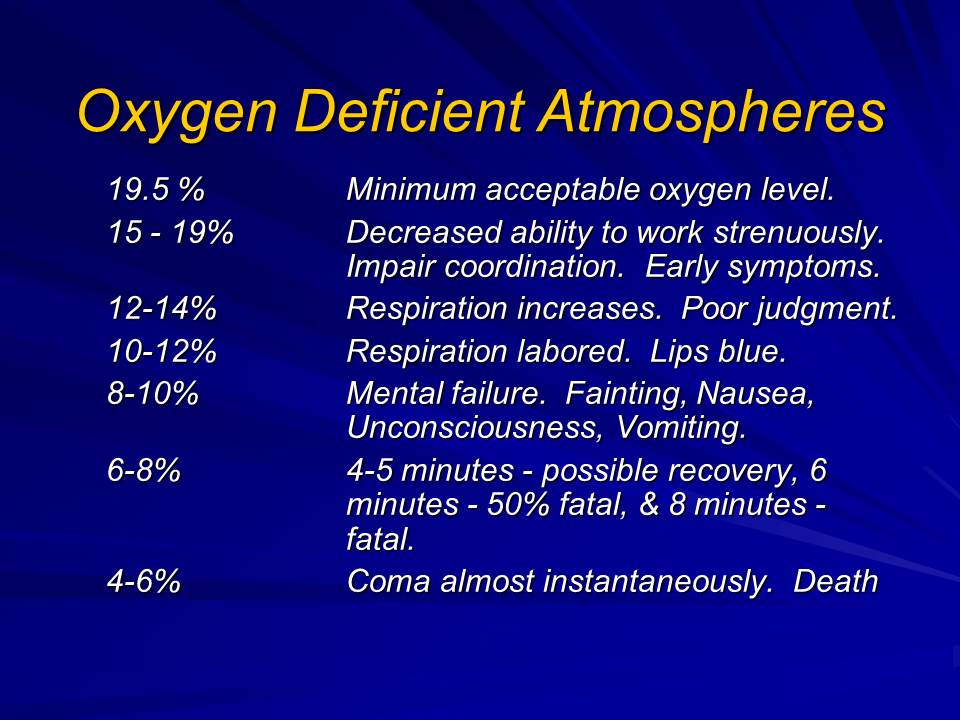
TEXT VERSION OF SLIDE:
Title: Oxygen Deficient Atmospheres
Type: Text Slide
Content:
- 19.5%
- Minimum acceptable oxygen level.
- 15-19%
- Decreased ability to work strenuously. Impair coordination. Early symptoms.
- 12-14%
- Respiration increases. Poor judgment.
- 10-12%
- Respiration labored. Lips blue.
- 8-10%
- Mental failure. Fainting, Nausea, Unconsciousness, Vomiting.
- 6-8%
- 4-5 minutes - possible recovery, 6 minutes - 50% fatal, & 8 minutes - fatal.
- 4-6%
- Coma almost instantaneously. Death

